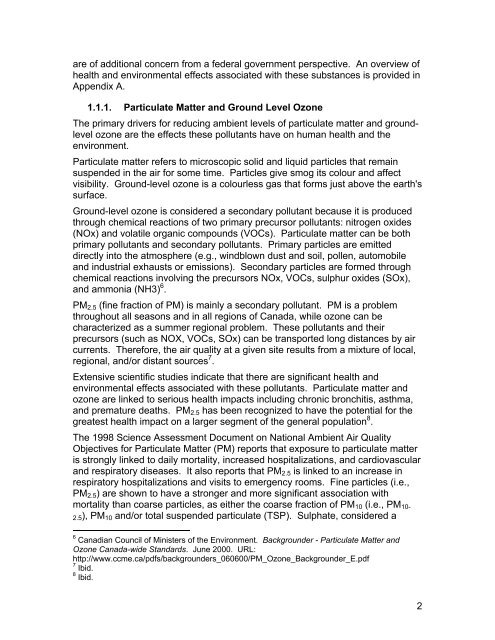(MERAF) for the Base Metals Smelting Sector - CCME
(MERAF) for the Base Metals Smelting Sector - CCME
(MERAF) for the Base Metals Smelting Sector - CCME
Create successful ePaper yourself
Turn your PDF publications into a flip-book with our unique Google optimized e-Paper software.
are of additional concern from a federal government perspective. An overview of<br />
health and environmental effects associated with <strong>the</strong>se substances is provided in<br />
Appendix A.<br />
1.1.1. Particulate Matter and Ground Level Ozone<br />
The primary drivers <strong>for</strong> reducing ambient levels of particulate matter and groundlevel<br />
ozone are <strong>the</strong> effects <strong>the</strong>se pollutants have on human health and <strong>the</strong><br />
environment.<br />
Particulate matter refers to microscopic solid and liquid particles that remain<br />
suspended in <strong>the</strong> air <strong>for</strong> some time. Particles give smog its colour and affect<br />
visibility. Ground-level ozone is a colourless gas that <strong>for</strong>ms just above <strong>the</strong> earth's<br />
surface.<br />
Ground-level ozone is considered a secondary pollutant because it is produced<br />
through chemical reactions of two primary precursor pollutants: nitrogen oxides<br />
(NOx) and volatile organic compounds (VOCs). Particulate matter can be both<br />
primary pollutants and secondary pollutants. Primary particles are emitted<br />
directly into <strong>the</strong> atmosphere (e.g., windblown dust and soil, pollen, automobile<br />
and industrial exhausts or emissions). Secondary particles are <strong>for</strong>med through<br />
chemical reactions involving <strong>the</strong> precursors NOx, VOCs, sulphur oxides (SOx),<br />
and ammonia (NH3) 6 .<br />
PM 2.5 (fine fraction of PM) is mainly a secondary pollutant. PM is a problem<br />
throughout all seasons and in all regions of Canada, while ozone can be<br />
characterized as a summer regional problem. These pollutants and <strong>the</strong>ir<br />
precursors (such as NOX, VOCs, SOx) can be transported long distances by air<br />
currents. There<strong>for</strong>e, <strong>the</strong> air quality at a given site results from a mixture of local,<br />
regional, and/or distant sources 7 .<br />
Extensive scientific studies indicate that <strong>the</strong>re are significant health and<br />
environmental effects associated with <strong>the</strong>se pollutants. Particulate matter and<br />
ozone are linked to serious health impacts including chronic bronchitis, asthma,<br />
and premature deaths. PM 2.5 has been recognized to have <strong>the</strong> potential <strong>for</strong> <strong>the</strong><br />
greatest health impact on a larger segment of <strong>the</strong> general population 8 .<br />
The 1998 Science Assessment Document on National Ambient Air Quality<br />
Objectives <strong>for</strong> Particulate Matter (PM) reports that exposure to particulate matter<br />
is strongly linked to daily mortality, increased hospitalizations, and cardiovascular<br />
and respiratory diseases. It also reports that PM 2.5 is linked to an increase in<br />
respiratory hospitalizations and visits to emergency rooms. Fine particles (i.e.,<br />
PM 2.5 ) are shown to have a stronger and more significant association with<br />
mortality than coarse particles, as ei<strong>the</strong>r <strong>the</strong> coarse fraction of PM 10 (i.e., PM 10-<br />
2.5), PM 10 and/or total suspended particulate (TSP). Sulphate, considered a<br />
6 Canadian Council of Ministers of <strong>the</strong> Environment. Backgrounder - Particulate Matter and<br />
Ozone Canada-wide Standards. June 2000. URL:<br />
http://www.ccme.ca/pdfs/backgrounders_060600/PM_Ozone_Backgrounder_E.pdf<br />
7 Ibid.<br />
8 Ibid.<br />
2
















